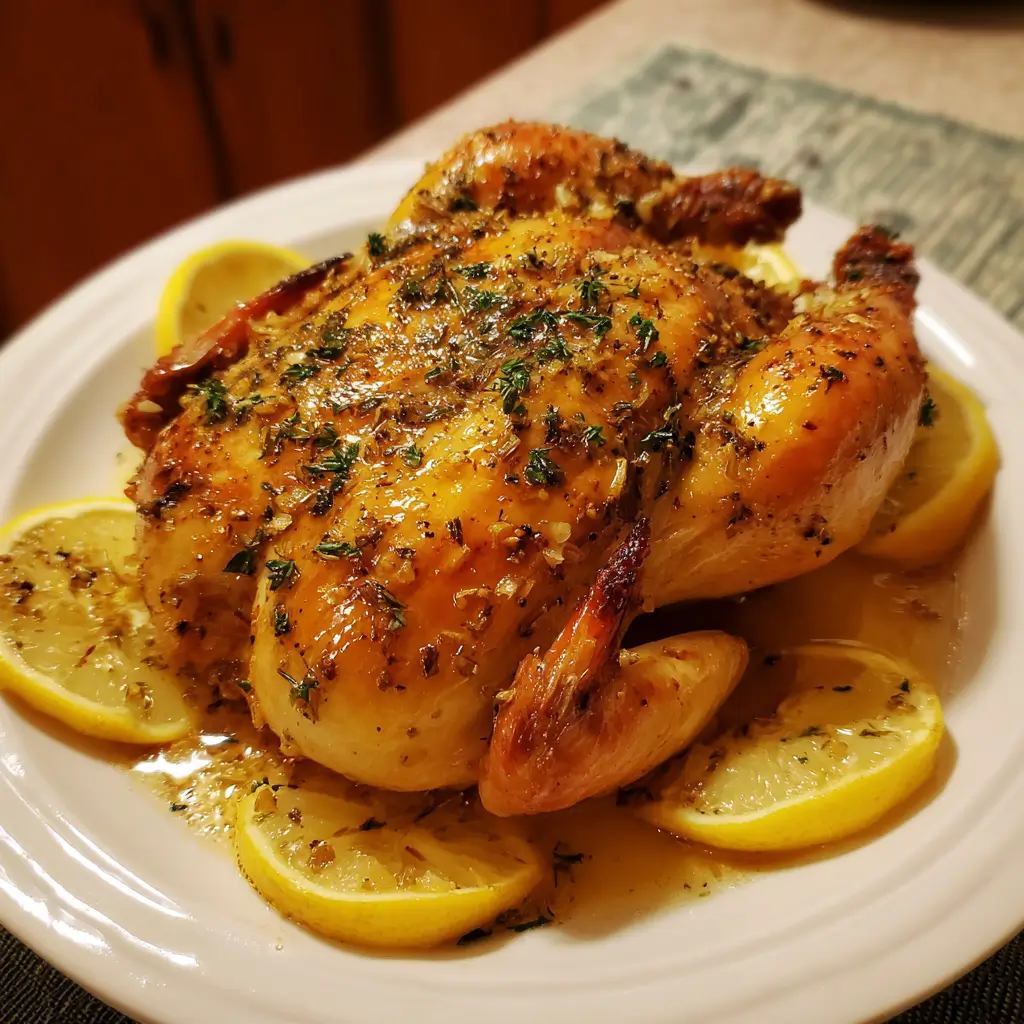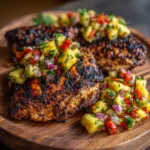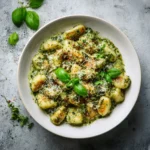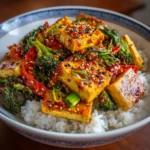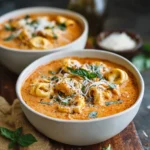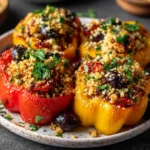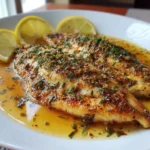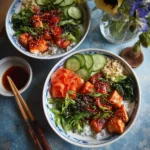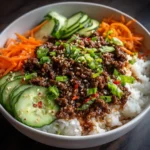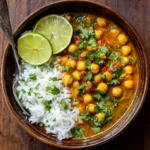Lemon Garlic Roasted Chicken: A Zesty, Flavor-Packed Classic
There’s something truly magical about the combination of lemon and garlic when it comes to roasting chicken. The bright acidity of lemon cuts through the richness of the poultry, while garlic infuses every bite with a deep, savory warmth. Lemon Garlic Roasted Chicken is more than just a meal—it’s a comforting centerpiece that brings families together at the dinner table, filling homes with an irresistible aroma that promises both flavor and nourishment. Whether served on a weeknight or for a weekend gathering, this dish strikes the perfect balance between simplicity and sophistication.
The History Behind the Dish
The roots of roasted chicken can be traced back thousands of years, appearing in culinary traditions across Europe, the Middle East, and Asia. However, the specific pairing of lemon and garlic with roasted chicken gained prominence in Mediterranean cuisine—particularly in Greek, Italian, and Southern French cooking. In these regions, fresh lemons grow abundantly, and garlic has long been celebrated for its bold flavor and medicinal properties. Ancient Romans seasoned roasted meats with garum (a fermented fish sauce) and herbs, but as citrus fruits made their way into European kitchens via trade routes from the Middle East, the use of lemon in meat dishes began to flourish.
By the Renaissance, lemon was a prized ingredient among European chefs for balancing rich flavors. In Provence, France, “Poulet au Citron” became a staple, often prepared with thyme, olive oil, and white wine. Similarly, in Greece, “Kotopoulo me Lemoni,” a lemon-oregano chicken stew, inspired many roasted variations. Over time, home cooks adapted these recipes for the oven, simplifying them for everyday meals while preserving the vibrant taste profile. Today, Lemon Garlic Roasted Chicken stands as a modern homage to these age-old traditions, combining rustic techniques with globally loved ingredients.
Ingredients Breakdown: What Makes This Dish Shine
The beauty of this recipe lies in its minimalism—each ingredient plays a crucial role in building layers of flavor and texture.
- Whole Chicken: A 4- to 5-pound (1.8–2.3 kg) chicken is ideal. Choose organic, free-range if possible for better flavor and texture.
- Fresh Lemons: Two large lemons—one juiced, one sliced. Lemon juice tenderizes the meat slightly and adds brightness; lemon slices placed inside the cavity steam the bird from within, imparting subtle citrus notes.
- Fresh Garlic: One whole head, with cloves separated and lightly crushed. Raw garlic mellows during roasting, becoming sweet and buttery, while still contributing depth.
- Olive Oil: High-quality extra virgin olive oil helps crisp the skin and carries the seasonings evenly.
- Fresh Herbs: Rosemary and thyme are classic pairings with poultry. Their earthy, pine-like aroma complements the citrus perfectly. Parsley can be added at the end for freshness.
- Salt and Black Pepper: Essential for seasoning. Use kosher salt for even distribution and superior flavor control.
- Optional Enhancements: White wine, chicken broth, onions, carrots, or potatoes can be added to the roasting pan for a complete one-pan meal.
Step-by-Step Recipe: How to Make Perfect Lemon Garlic Roasted Chicken
- Preparation: Remove the chicken from the refrigerator 30 minutes before cooking to bring it to room temperature—this ensures even roasting. Pat the chicken dry thoroughly with paper towels. Moisture is the enemy of crispy skin!
- Season the Cavity: Sprinkle the inside of the chicken with salt and pepper. Stuff the cavity with half the crushed garlic cloves, one halved lemon, a few sprigs of rosemary and thyme, and optionally, quartered onion or celery for extra aroma.
- Create the Lemon-Garlic Paste: In a small bowl, combine the remaining crushed garlic, 3 tablespoons of olive oil, juice of one lemon, 1 teaspoon salt, ½ teaspoon black pepper, 1 tablespoon chopped rosemary, and 1 tablespoon chopped thyme. Mix into a loose paste.
- Season the Exterior: Gently loosen the skin over the breast and thighs using your fingers. Carefully spread about two-thirds of the lemon-garlic paste underneath the skin, directly onto the meat. Rub the rest of the paste all over the outside of the chicken.
- Truss the Chicken (Optional): Tie the legs together with kitchen twine and tuck the wing tips under the body. Trussing helps the chicken cook evenly and retain moisture.
- Prepare the Roasting Pan: Place chopped onions, carrots, potatoes, or other vegetables in a large roasting pan or Dutch oven. Drizzle with olive oil and sprinkle with salt and pepper. Pour in ½ cup of chicken broth or white wine to prevent drying and create a flavorful pan sauce.
- Raise the Bird: Set the chicken on a roasting rack over the vegetables (or directly on top if no rack). This allows air to circulate, promoting even browning.
- Roast: Preheat the oven to 425°F (220°C). Roast the chicken for 15 minutes at this high heat to crisp the skin, then reduce the temperature to 375°F (190°C). Continue roasting for approximately 1 hour to 1 hour 20 minutes, or until the internal temperature reaches 165°F (74°C) in the thickest part of the thigh (avoiding bone).
- Baste Occasionally: Every 25–30 minutes, spoon pan juices over the chicken to keep it moist and enhance flavor.
- Rest Before Carving: Once done, remove the chicken from the oven, tent loosely with foil, and let it rest for 15–20 minutes. This allows juices to redistribute, ensuring tender, juicy meat.
- Serve: Carve the chicken and serve with roasted vegetables and a drizzle of pan juices. Garnish with fresh parsley and additional lemon wedges.
Pro Tips for the Best Results
- Dry Skin = Crispy Skin: Always pat the chicken dry before seasoning. For ultra-crispy skin, leave the bird uncovered in the fridge overnight.
- Use a Meat Thermometer: Don’t guess doneness. Insert the thermometer into the inner thigh without touching bone for accuracy.
- Don’t Skip the Rest: Cutting too soon releases precious juices, leading to drier meat.
- Enhance Browning: For deeper color, broil for 2–3 minutes at the end—but watch closely to avoid burning.
- Save the Juices: The drippings are gold! Skim excess fat and use them as a base for gravy or sauces.
- Double the Garlic: If you’re a garlic lover, go ahead—roasted garlic becomes creamy and sweet, not harsh.
Variations and Customizations
This recipe is highly adaptable to different tastes and dietary needs:
- Herb Variations: Swap rosemary and thyme for sage, oregano, tarragon, or herbes de Provence.
- Spicy Kick: Add red pepper flakes or a minced chili to the garlic paste.
- Citrus Swap: Try orange, lime, or grapefruit instead of lemon for a unique twist.
- Dairy-Free & Gluten-Free: Naturally compliant—just ensure any added broth or wine is certified GF if needed.
- Half-Chicken Option: Roast only the breasts or legs for smaller servings. Adjust cooking time accordingly.
- Marinated Version: Let the chicken sit with the lemon-garlic paste in the fridge for 4–12 hours (or overnight) for deeper flavor penetration.
- One-Pan Meal: Surround the chicken with potatoes, carrots, onions, Brussels sprouts, or fennel for a complete dinner with minimal cleanup.
- Grilled Version: Use indirect heat on a charcoal or gas grill for a smoky variation.
Health Considerations and Nutritional Value
Lemon Garlic Roasted Chicken isn’t just delicious—it can be part of a balanced, nutritious diet.
- High-Quality Protein: Chicken is an excellent source of lean protein, essential for muscle repair, immune function, and satiety.
- Healthy Fats: Olive oil provides heart-healthy monounsaturated fats and antioxidants like vitamin E.
- Garlic Benefits: Known for its anti-inflammatory and immune-boosting properties, garlic contains allicin, which may help lower blood pressure and cholesterol.
- Lemon Power: Rich in vitamin C, lemon supports collagen production, iron absorption, and antioxidant defense.
- Low Carb & Keto-Friendly: With no added sugar and minimal carbs, this dish fits well into low-carb and ketogenic lifestyles—especially when served with non-starchy vegetables.
- Watch Sodium: Control salt levels by using low-sodium broth and adjusting added salt to dietary needs.
- Bone-In vs. Boneless: Bone-in, skin-on chicken retains more moisture and flavor during roasting and offers trace minerals from the bones when making stock later.
Nutritional Estimate (per serving, 1/4 of a 4-lb chicken with skin, without sides):
- Calories: ~450–500
- Protein: 45g
- Fat: 30g (saturated fat: 8g)
- Carbohydrates: 2g
- Fiber: 0g
- Vitamin C: 30% DV
- Iron: 10% DV
- Zinc: 25% DV
Full Ingredient List
- 1 whole chicken (4–5 lbs / 1.8–2.3 kg)
- 2 large lemons
- 1 whole head of garlic, separated into cloves
- ¼ cup extra virgin olive oil (divided)
- 1 tbsp fresh rosemary, finely chopped (or 1 tsp dried)
- 1 tbsp fresh thyme leaves (or 1 tsp dried)
- 1 ½ tsp kosher salt (adjust to taste)
- ½ tsp freshly ground black pepper
- 1 medium onion, roughly chopped (optional)
- 2 carrots, chopped (optional)
- 2 celery stalks, chopped (optional)
- ½ cup chicken broth or dry white wine
- Fresh parsley, chopped (for garnish)
- Kitchen twine (for trussing, optional)
Detailed Directions
- Preheat oven to 425°F (220°C). Place a roasting rack inside a large roasting pan or Dutch oven.
- Pat the chicken dry with paper towels. Season the inside cavity with ½ tsp salt and ¼ tsp pepper.
- Stuff the cavity with 5–6 garlic cloves, 1 halved lemon, 2 sprigs each of rosemary and thyme, and optional onion or celery.
- In a bowl, mix 3 tbsp olive oil, juice of 1 lemon, remaining chopped herbs, 1 tsp salt, ¼ tsp pepper, and the remaining garlic cloves (lightly crushed).
- Gently separate the skin from the breast and thighs. Spread ⅔ of the garlic-herb paste under the skin. Rub the rest over the exterior.
- Truss the chicken with twine if desired. Place it breast-side up on the rack.
- In the roasting pan around the chicken, add chopped onions, carrots, and celery. Drizzle with 1 tbsp olive oil, season with salt and pepper, and pour in chicken broth or wine.
- Roast at 425°F for 15 minutes. Then reduce heat to 375°F (190°C) and continue roasting for 60–80 minutes, basting every 30 minutes.
- Check doneness: Insert a meat thermometer into the inner thigh—it should read 165°F (74°C). Juices should run clear when pierced.
- Remove from oven, tent with foil, and rest for 15–20 minutes.
- Carve and serve with roasted vegetables and pan juices. Garnish with fresh parsley and lemon wedges.
Frequently Asked Questions (FAQ)
Can I use chicken pieces instead of a whole chicken?
Yes! Adjust cooking time: bone-in thighs or drumsticks take 35–45 minutes; breasts take 25–35 minutes at 375°F. Watch carefully to avoid drying.
Can I make this ahead of time?
Absolutely. You can prep and marinate the chicken up to 24 hours in advance. Roast just before serving for best texture.
How do I store leftovers?
Cool completely, then refrigerate in an airtight container for up to 4 days. Reheat gently in the oven or microwave.
Can I freeze Lemon Garlic Roasted Chicken?
Yes. Freeze carved meat in portions for up to 3 months. Thaw in the fridge before reheating. Texture may soften slightly.
Why is my chicken skin not crispy?
Moisture is the culprit. Ensure the chicken is fully dry before seasoning, and avoid covering during roasting. Starting at high heat also helps.
What can I do with leftover carcass?
Simmer it with water, onions, carrots, celery, and herbs for 2–4 hours to make a rich, homemade chicken stock.
Is this recipe suitable for meal prep?
Definitely! Roast the chicken on Sunday and use throughout the week in salads, wraps, soups, or grain bowls.
Can I use bottled lemon juice?
Freshly squeezed lemon juice is strongly recommended for superior flavor and acidity. Bottled versions often contain preservatives and lack vibrancy.
Summary
Lemon Garlic Roasted Chicken is a timeless, aromatic dish that combines bright citrus, savory garlic, and tender poultry into a foolproof family favorite. With simple ingredients and flexible customization, it delivers restaurant-quality flavor straight from your own kitchen.
